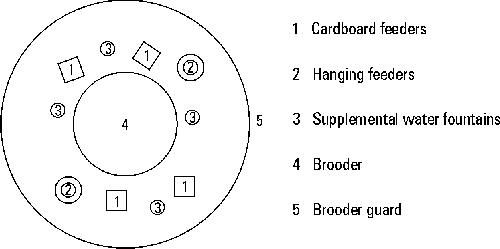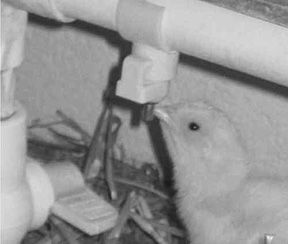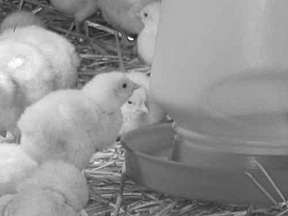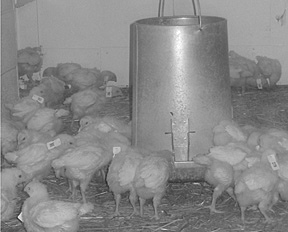| | Management | Barn, yard and equipment setup | Nutrition
Small poultry flock owners often experience problems of one sort or another with their young birds. In the majority of cases, the problems are related to either management or nutrition. Helpful hints and facts have been collected in this factsheet to help producers avoid many of these problems.
Management
The success of a flock, one that will grow, live and lay well, begins long in advance of bird delivery. In fact, it begins right after the old flock leaves.
Your facilities, including barns, equipment and yard, have to be cleaned and thoroughly disinfected. Many disease-causing organisms, such as those that cause coccidiosis, Marek's disease, fowl tuberculosis, fowl cholera and blackhead, can remain in the soil, dust or litter for several months or, in some cases, several years.
Cleaning and disinfecting
As soon as your birds are marketed, all portable equipment should be removed from the poultry house, washed and disinfected thoroughly. A high-pressure washer is ideal for washing. If you do not have one, a garden hose with an attachment that injects soap/chemicals will suffice.
Using soap or detergent, wash all dust, dirt and organic material from the walls, ceilings, fans and water lines. This step can be done before the litter is removed because the litter will absorb the water. Removing the litter will be easier if you have a concrete or wood floor.
The Agricultural Operation Practices Act (AOPA) regulates how manure is handled. Small poultry farmers (less than 2,000 broilers) are not required to register with AOPA, but are still expected to meet the requirements of the act.
AOPA states that manure, composting materials and compost can only be applied to arable land and must be incorporated within 48 hours, except when applied to forage crops, direct-seeded crops, and frozen and snow-covered soils. Manure, composting materials and compost can be spread without incorporation on forage or direct-seeded crops provided the manure application is at least 150 metres from a residence or other building or structure occupied by people, and the slope setbacks set out in AOPA are met.
More details on AOPA can be found on Alberta Agriculture, Food and Rural Development's website Ropin' the Web.
Manure should be moved as far from the poultry barn as possible, since insects, mice, pets, wild birds and humans can easily reinfect a poultry house that has been cleaned and disinfected, simply by walking over or around the manure pile.
Once the litter has been removed, the house must be disinfected. Several disinfectants are available from local farm supply stores, hatcheries or feedmills. See Table 1 for a list.
No matter which disinfectant you choose, follow the label directions exactly. Do not mix different types of disinfectants.
Water fountains, trough feeders and other portable equipment can be disinfected with the same products. If the weather permits, leave the equipment out in the sun. Ultraviolet light is a good germicide.
Outdoor runs should have the manure scraped away to expose the fresh soil underneath, then cultivate the soil and leave it exposed to the elements and sunlight for as long as possible before repopulating. Rotate your outdoor poultry areas if you have the space, which can be done easily if a portable brooder house is used.
The longer a facility remains idle without birds or organic material, the more likely it is that disease-causing organisms will be killed.
Barn, Yard and Equipment Set-up
Litter
The best type of litter or bedding material to use is coarse wood shavings. Avoid sawdust and fine shavings because they can lead to litter picking by chicks or poults and can result in death due to gizzard impaction. Shavings are convenient to use and easy to spread, and they can be purchased in bales, bags or in bulk.
The other commonly used bedding is chopped wheat straw. Other varieties of straw such as rye, oat or barley contain oils that reduce the straw's ability to absorb moisture. These kinds of straw also tend to be more coarse.
Many small flock owners have used peat moss, mainly because of its availability and price. Under no circumstances should ordinary garden sphagnum peat moss be used. This kind of peat moss has not been sterilized to kill moulds and fungi that are always present. Birds will breathe the mold and develop pneumonia or generalized infections. Only peat moss that is labelled for use with poultry should be used. Shredded paper can also be used for poultry litter.
The bedding material should be leveled and spread to a thickness of 10 cm (4 in.). Do this a week or two before the birds arrive to allow the material to dry completely. Damp litter can produce mold and will promote the growth of the organisms that cause coccidiosis.
Outside the brooder house, good fencing is necessary to eliminate losses due to predation. Skunks, coyotes, foxes and raptors such as hawks and owls can cause the "mysterious" loss of birds.
A 2 m (6 ft) high perimeter fence will suffice, and it is a good idea to use 2.5 m (8 ft) wire, digging the bottom
60 cm (2 ft) into the ground and angling it outwards from the pen. Most predators will come up to the edge of a fence and try and dig down underneath. By angling the wire outward, the animal will dig down and hit this wire and will generally move down the fence and try another spot. After digging down to the wire two or three times, most predators will give up.
If hawks or owls have been a problem in the past, nylon netting can be used to cover the pens. Many small flock owners have reported success by placing a plastic life size replica of an owl on the roof of their brooder house. Several farm supply stores carry these replicas.
Barn heating and temperature
The most common sources of heat for small flocks are electric brooder lamps and liquid propane gas or natural gas brooder stoves.
The temperature of the brooding area should be 32°C (90°F) at chick height when placing broiler chicks. Temperature of the brooding area should be reduced gradually by 3°C (5°F) per week until 21°C (70°F) is reached. Turkey poults must be brooded at a higher temperature, i.e. 35°C (95°F). The same 3°C per week reduction can be followed.
Preheat the brooding area a couple of days before the birds arrive to ensure that the litter is heated to the proper temperature. Cold floors can weaken a bird's immune system. A higher incidence of ascites or water belly has been recorded when birds are brooded on cold floors.
Preheating the brooding area will allow growers to ensure that all equipment is functioning properly and permit time to buy parts it necessary. Have the waterers filled with room temperature water when the birds arrive. If a gas brooder stove is being used, be sure that there is plenty of fresh air in the brooding area.
Finally, observe the flock carefully. They are your best thermometer. Huddled birds are too cold, and birds that are panting and crowding against the brooder guard are too hot. If the temperature is ideal, the flock will be evenly spaced over the entire brooding area.
Equipment
Figure 1 shows a typical feeder, waterer and brooder stove layout suitable for both chicks and poults. The surrounding cardboard chick guard serves several purposes. It keeps the birds confined, so they are in closer contact with feed and water. It keeps drafts away from the flock, and the circular chick guard eliminates corners. All classes of poultry will head for corners if they are frightened or too hot or too cold.

Figure 1. Brooding diagram
Nipple drinkers are the best choice for providing clean water to poultry (Figure 2). One nipple drinker can supply up to 20 birds with water. When starting a flock on nipple drinkers, be sure to maintain a high light intensity, which will attract young birds to the nipple drinkers.

Figure 2. Nipple drinkers
If supplemental fountain (see Figure 3) or bell drinkers are used to start a flock, be sure that all birds find the nipple drinkers when the supplemental drinkers are removed. High light intensity and careful attention to nipple drinker height can make supplemental drinkers unnecessary.

Figure 3. Supplementary fountain drinker
Light intensity should be no less than 20 lux (2 foot candles) during the first 3 days of life. An intensity of 20 lux is roughly equivalent to the amount of light given off by a streetlamp. Light intensity that is too high can trigger aggressive behaviours such as feather pecking or cannibalism. Following the first 3 days of life, light intensity should provide adequate lighting for feed and water intake as well as normal activity.
The standard three-foot trough feeder works well for both chicks and poults. The trough feeder can be replaced with hanging feeders once the birds reach two to three weeks of age. Typically, these hanging feeders will hold about 20 kg (50 lb) of feed (see Figure 4).

Figure 4. Hanging feeder
Floor space requirement
Meat-type chickens and egg layers should be allowed 0.19 m2 (2 ft2) of floor space per bird while heavier breeds of turkeys require 0.47 m2 (5 ft2) of area per bird. These areas are lower than recommendations for commercial flocks, because ventilation systems for small flocks are not adequate to support commercial stocking rates.
Nutrition
Both chickens and turkeys will often be delivered to the flock owner at the same time. Owners may notice a difference in the price of the turkey and chicken feed and may opt for the less expensive chicken feed. As a result, many owners will brood the two species together. Brooding the two species together is not recommended for several reasons.
To develop a good skeletal system along with a strong, healthy musculature, turkey poults require a starter feed that contains a minimum of 28 per cent protein. Chicks need only about 22 to 24 per cent protein in the feed. Turkey poults may suffer from leg weakness and fail to thrive if they receive less than a 28 per cent protein starter.
Turkey starter feeds usually contain both a coccidiostat and a blackhead preventative whereas chick starter only has a coccidiostat. Blackhead in turkeys can devastate a flock - 100 per cent mortality in some cases. Turkeys reared in outdoor runs are far more susceptible to this disease because it can be spread by earthworms. Outdoor runs for turkeys should be moved between cycles.
Turkeys require a warmer brooding temperature than chicks. Chicks that are brooded with turkeys at the higher temperature are more likely to have sticky feces, which can result in pasting of the vent. Cannibalism may become a problem if birds are too hot.
Broilers should be fed a commercial medicated chick starter until they reach three to four weeks of age. Medicated feeds prevent disease, especially necrotic enteritis. A feed utilizing a chick grower supplement and grains can then be gradually introduced. All birds require grit, which is used in a specially developed digestive organ called the gizzard to grind feed. Granite grit must be included in the diet if the flock will be receiving "homemade" feed.
When planning a feeding program, be sure that the chicks will receive sufficient micronutrients and vitamins. Some "homemade" feeds may cheat birds of vital ingredients. It is a good idea to purchase some chick grower supplement to be added to the feed. Be sure to follow the directions on the tag. About 10 days to 2 weeks before the flock is ready to be processed, switch to a non-medicated finisher supplement. This step will ensure that withdrawal times for any medications are followed.
Laying hens or pullets are a different story. Do not feed these birds a broiler ration because they will become too fat, and egg production will suffer as a result. Pullets that are too fat at the onset of lay are also prone to prolapse and vent picking. Some coccidiostats that are routinely used in broiler feeds should not be fed to egg layers.
Specially designed feeds for pullets and laying hens are available at feed mills. If you should have any doubts as to what program to follow, contact your feed mill.
Remember to:
- clean and disinfect all buildings and equipment before any chicks arrive
- preheat the brooding area to 35°C (95°F) for turkeys, 32°C (90°F) for chickens
- brood chicks and poults seperately
- provide plenty of fresh air
- provide plenty of fresh, clean, potable water (room temperature)
- provide plenty of fresh, high-quality, 24 per cent medicated chick starter for your day old chicks and 28 per cent medicated turkey starter for your day old poults.
Prepared by:
R.J. Chernos
B. Schneider
Source: Agdex 450/22-1. Revised August 2004. |
|